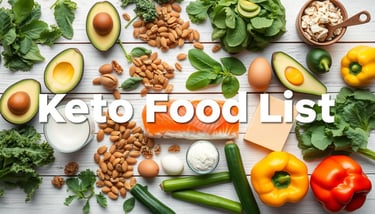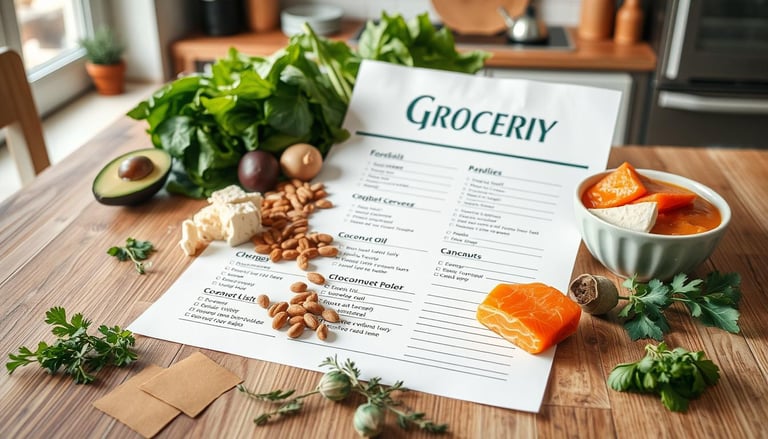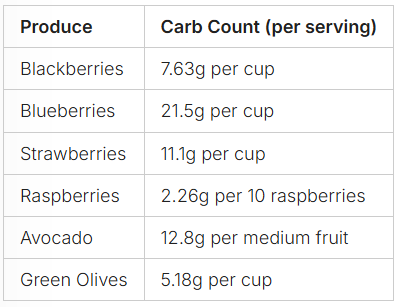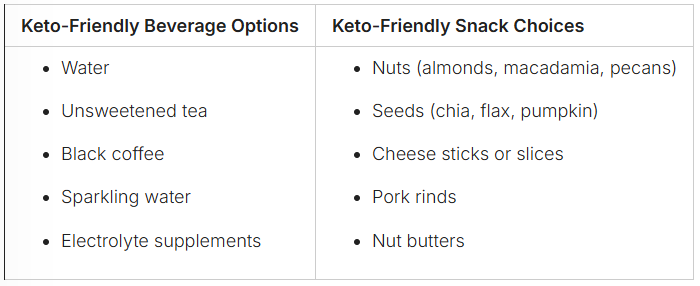Grocery Shopping for Keto: Your Complete Guide
Discover essential tips for grocery shopping for keto success. Learn what to buy, what to avoid, and how to stock your kitchen for a sustainable ketogenic lifestyle
Average Guy
12/12/20249 min read


Grocery Shopping for Keto: Your Complete Guide
When I walk into the grocery store, I see lots of colorful foods. But I know I need to stick to my keto diet. The keto diet focuses on eating lots of fat and very few carbs. It can really improve your health, but finding the right foods can be tricky at first.
Don't worry, keto fans! This guide will help you shop for keto foods easily and without stress.
Key Takeaways
The keto diet requires limiting carb intake to 20-40 grams per day to achieve ketosis.
Focus on nutrient-dense, high-fat foods like avocado, fatty fish, and leafy greens.
Avoid high-carb foods like grains, starchy vegetables, and most fruits.
Read labels carefully to identify hidden sugars and carbs.
Plan your meals and create a comprehensive keto grocery list to stay on track.
Understanding the Ketogenic Diet Fundamentals
The ketogenic diet is a high-fat, moderate-protein, and low-carb eating plan. It has become very popular in recent years. This diet makes your body burn fat for energy instead of carbs.
By eating fewer carbs, usually less than 50 grams a day, your body goes into a fat-burning state. This state is called ketosis. It can bring many benefits.
What Makes a Diet Ketogenic
The ketogenic diet has a specific mix of nutrients. It includes
Carbs: 5% or less of total calories
Protein: 20-25% of total calories
Fat: 70-75% of total calories.
This means most people eat about 25-50 grams of carbs daily.
Sticking to this ratio is key to staying in ketosis.
The Science Behind Ketosis
When you're in ketosis, your body uses fat as its main energy source. It breaks down fat into ketones. These ketones power your body, including your brain.
This change can improve blood sugar control and boost mental clarity and focus.
Benefits and Considerations
Weight loss and fat-burning: The keto diet can help you lose weight by burning more fat and lowering insulin levels.
Improved blood sugar regulation: It can stabilize blood sugar and improve insulin sensitivity, helping those with type 2 diabetes or PCOS.
Enhanced cognitive function: Ketones can fuel your brain, improving mental clarity, focus, and energy.
Potential therapeutic applications: Low-carb diets, like the keto diet, may help with drug-resistant epilepsy and other conditions.
But, the keto diet can be hard to follow and may cause side effects like the "keto flu." This includes fatigue, headaches, and nausea. Always talk to a healthcare professional before starting a new diet.
Essential Keto Macronutrients and Food Categories
A ketogenic diet focuses on eating lots of fat, some protein, and very few carbs. To stay in ketosis, where your body uses fat for energy, knowing the right foods is key.
Protein Sources
Protein should be 10-20% of your daily calories on a keto diet. Good protein sources include:
Beef (17.2 g protein, 20 g fat per 100 g)
Chicken wings (14 g protein, 11 g fat per 100 g)
Pork loin (27.3 g protein, 13.9 g fat per 100 g)
Fatty fish like salmon (20.4 g protein, 13.4 g fat per 100 g)
Shellfish such as shrimp (24 g protein, 0.28 g fat per 100 g)
Eggs (6 g protein, 4 g fat per whole egg)
Healthy Fats
Fats should be 70-80% of your daily calories on a keto diet. Good fats include:
Olive oil (14 g fat per tablespoon)
Butter (11.5 g fat per tablespoon)
Nuts and seeds like Brazil nuts (67.1 g fat per 100 g) and chia seeds (30.7 g fat per 100 g)
Low-Carb Vegetables
Vegetables are crucial in a keto diet, offering nutrients while keeping carbs low. Some good options are:
Leafy greens like spinach (3.63 g net carbs per 100 g)
Cruciferous veggies such as broccoli (6.64 g net carbs per 100 g)
Celery (2.97 g net carbs per 100 g)
Lettuce (3.29 g net carbs per 100 g)
Cabbage (5.8 g net carbs per 100 g)
To succeed on a keto diet, eat whole, unprocessed foods. Count your net carbs (total carbs minus fiber) to stay within limits. Knowing the right foods helps you make a good keto grocery list for your health and fitness goals.

Grocery Shopping for Keto: Building Your Shopping List
Shopping for keto can be easy with the right foods. Start by stocking up on high-quality protein, healthy fats, and low-carb veggies. This will help you make tasty, healthy meals that help your body get into ketosis.


Protein Sources
Protein is key on the keto diet. Choose grass-fed meats, organic poultry, fatty fish, and pasture-raised eggs for the best quality. Good options include:
Grass-fed beef
Free-range chicken and turkey
Wild-caught salmon, tuna, and other fatty fish
Pastured pork
Whole eggs
Healthy Fats Selection
Fats are the base of the keto diet. Pick healthy fats for nutrients and health. Add avocados, olive oil, coconut oil, nuts, and seeds to your diet. Some great choices are:
Avocados
Extra virgin olive oil
Coconut oil
Nuts (almonds, macadamia nuts, walnuts)
Seeds (chia, flax, hemp)
Low-Carb Vegetables Guide
Non-starchy veggies are vital for a keto diet. Choose leafy greens, cruciferous veggies, and low-carb options for vitamins, minerals, and fiber. Top picks include:
Spinach, kale, and other leafy greens
Broccoli, cauliflower, and other cruciferous veggies
Zucchini, cucumber, and other low-carb squashes
Peppers, onions, and tomatoes (in moderation)
Always check labels and choose whole foods. By focusing on these foods, you'll make a great keto shopping list. Enjoy the benefits of the ketogenic lifestyle.
Smart Shopping Tips for Keto Success
Shopping for a ketogenic diet can be tough. But, with some smart tips, you can make it easier. Let's look at ways to keep your keto journey on track.
Meal Planning: The Key to Avoiding Impulse Buys
Start by planning your meals for the week. This makes a detailed shopping list and stops impulse buys. Choose keto-friendly recipes and list the ingredients you need.
Label Reading: Uncover Hidden Carbs and Sugars
When shopping, read labels carefully. Look for net carb counts and watch for hidden sugars. Stick to whole foods to get the right nutrients.
Bulk Buying: Savings and Convenience
Buy keto staples like nuts, seeds, and dairy in bulk. It saves money and keeps you stocked for keto meals.
Keto-Friendly Brands: Explore Your Options
While whole foods are key, keto brands offer tasty and convenient options. Look for low-carb bars, baking mixes, and snacks to mix up your meals.
Use these tips to make your shopping easier. With planning and careful choices, you can fill your kitchen with the right keto foods. This fuels your healthy lifestyle.

Must-Have Keto Pantry Staples
Keeping a well-stocked keto pantry is key to your success. You'll need essential oils and versatile baking ingredients. These make meal prep easier and help you stay on track with your low-carb diet.
Cooking Oils and Fats
Make sure your keto pantry has healthy fats like olive oil, coconut oil, and avocado oil. They're good for cooking and offer many benefits. Also, have ghee and MCT oil ready for extra healthy fats.
Herbs and Seasonings
Herbs and spices can make your keto meals taste great without adding carbs. Fill your pantry with low-carb options like garlic, rosemary, thyme, cumin, and paprika. Try different mixes to keep your meals tasty and varied.
Keto-Friendly Baking Items
Almond flour and coconut flour are must-haves for low-carb baking. They make keto treats sturdy and flavorful.
Keep erythritol or other keto-approved sweeteners for sweet cravings without carbs.
Remember to have baking powder, cream of tartar, and egg white powder for better keto baking.
With these keto staples, you're set to make tasty and healthy low-carb meals. They'll help you stay in ketosis.
Fresh Produce Selection for Keto Diet
Following a ketogenic diet means focusing on low-carb veggies and some fruits. These foods help keep you in ketosis. They also give you important vitamins, minerals, and fiber.
Spinach, kale, broccoli, and cauliflower are top picks for low-carb veggies. They're full of nutrients and have very few carbs. You can also add zucchini, mushrooms, and bell peppers to your meals.
For fruits, berries like blackberries, blueberries, raspberries, and strawberries are good choices. They're low in carbs and high in fiber. Avocados and olives are also great for their healthy fats.
Choose seasonal produce and go for organic when you can. This is especially true for the "Dirty Dozen" fruits and veggies. Organic options are better for your health and reduce pesticide intake.


Keto-Friendly Beverages and Snacks
It's important to stay hydrated and fueled on a keto diet. Drink water, unsweetened sugar-free drinks, and electrolyte-rich beverages to keep your hydration levels right. Good choices include unsweetened teas, black coffee, and sparkling water.
For keto snacks, pick foods rich in nutrients like nuts, seeds, cheese, and pork rinds. Choose sugar-free and low-carb options, like stevia-sweetened drinks, to curb cravings without breaking your diet. Remember, limit your alcohol intake to dry wines or spirits in small amounts.
Make keto-friendly snacks at home to have easy, diet-friendly choices. This keeps you on track and supports your health and wellness goals.


The keto diet lets you have 5-10% of your calories from carbs. That's less than 20 grams a day. By picking the right low-carb produce, you can eat well and stay in ketosis.
Protein and Dairy Section Navigation
When you're on a ketogenic diet, it's key to choose high-quality protein and fats. Look for grass-fed beef, wild-caught fish, full-fat dairy, and organic eggs in the aisles. This helps you get the nutrients your body needs.
Best Meat Choices
Choose fatty cuts of grass-fed beef, pork, and lamb for healthy fats. Stay away from processed meats like bacon and sausage. They have unhealthy additives. Instead, pick leaner cuts like flank steak and lamb chops.
Dairy Products Selection
For dairy, go for full-fat options like cheese and heavy cream. Avoid low-fat dairy with added sugars. A great snack is organic eggs with full-fat cheese.
Seafood Options
Add wild-caught fish like salmon to your diet. They're full of omega-3s, which fight inflammation.
Shrimp, tuna, and cod are also good. They're low in carbs and high in protein.
By choosing these protein and dairy options, you can make tasty keto meals. These meals will keep you full and on track with your health goals.


Conclusion
Successful keto grocery shopping means planning ahead, reading labels, and choosing whole foods. Focus on healthy fats, moderate protein, and low-carb veggies. This helps build a strong keto lifestyle.
Make sure your pantry is stocked with keto must-haves for easy meal prep. This makes it simpler to adapt to the keto diet.
Keep in mind, the health benefits of the keto diet can differ for everyone. Always talk to healthcare experts, especially if you have health issues. With good planning and a well-equipped kitchen, living a ketogenic lifestyle can be easier and more fun.
By following these tips, you'll be closer to your keto goals. You'll also be embracing a sustainable keto lifestyle that supports your health and wellness.
FAQ
What is the ketogenic diet?
The ketogenic diet is a diet high in fat and low in carbs. It helps your body burn fat for energy instead of carbs.
What are the macronutrient ratios for a ketogenic diet?
This diet limits carbs to 50g or less daily. It aims for 60-75% of calories from fat and 15-30% from protein.
What are the potential benefits of the ketogenic diet?
It may help with weight loss, better blood sugar control, and clearer thinking.
What are some common keto-friendly foods?
Foods like avocados, olive oil, and nuts are good. Also, eggs, meat, and fish are okay. Plus, leafy greens and cruciferous veggies are low in carbs.
What should I focus on when grocery shopping for keto?
Buy whole, unprocessed foods. Read labels to know carb counts. Avoid grains, sugars, and starchy veggies.
What are some essential keto pantry staples?
Keep olive oil, coconut oil, herbs, and spices handy. Also, almond flour, coconut flour, and sugar substitutes like monk fruit sweetener, allulose, or stevia are key.
How can I stay hydrated and choose keto-friendly snacks?
Drink water, unsweetened tea, and coffee. Snack on nuts, seeds, cheese, and pork rinds. Choose sugar-free options and be careful with alcohol.
Your journey to weight loss starts here.
contact@averageguyfattofit.org
© 2024. All rights reserved.